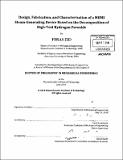| dc.contributor.advisor | Carol Livermore. | en_US |
| dc.contributor.author | Eid, Feras | en_US |
| dc.contributor.other | Massachusetts Institute of Technology. Dept. of Mechanical Engineering. | en_US |
| dc.date.accessioned | 2011-03-07T15:20:46Z | |
| dc.date.available | 2011-03-07T15:20:46Z | |
| dc.date.copyright | 2010 | en_US |
| dc.date.issued | 2010 | en_US |
| dc.identifier.uri | http://hdl.handle.net/1721.1/61596 | |
| dc.description | Thesis (Ph. D.)--Massachusetts Institute of Technology, Dept. of Mechanical Engineering, 2010. | en_US |
| dc.description | Cataloged from PDF version of thesis. | en_US |
| dc.description | Includes bibliographical references (p. 147-152). | en_US |
| dc.description.abstract | Microscale ejector pumps offer the potential for high flow rate pumping of gases, a functionality that is greatly needed in MEMS technology. These pumps have many additional characteristics, such as their simplicity of design and their lack of moving parts, which favor them over other state-of-the-art MEMS gas pumps. One of the challenges associated with driving ejector pumps, however, is providing a compact source of motive fluid. This fluid is the high-speed gas that drives the pumping action. The current thesis presents a MEMS device capable of generating steam at speeds suitable for driving an ejector pump in a compact fashion. To that end, the device utilizes the homogeneous catalytic decomposition of hydrogen peroxide. Analysis shows that a MEMS ejector pump driven by this device is capable of handling mass flow rates per unit pump volume on the order of 10-2 g/s/cm 3, which are two orders of magnitude higher than those of state-of-the art MEMS gas pumps. In addition to pumping, the steam generator may also be used for microrocket thrust generation in micropropulsion applications. In this thesis, the design, fabrication, testing, and successful demonstration of the MEMS steam generator are presented. The device consists of a mixing section for the peroxide and catalyst streams, a reactor section where the peroxide decomposes, and finally a nozzle section where the gaseous products of the decomposition are accelerated to the required velocities. To design the device, multidomain (chemical, thermal, and fluidic) numerically-implemented modeling is used to study the underlying physics and arrive at an optimized, microfabricatable design. The modeling takes into account the key challenges of thermal management, achieving fast mixing, and boundary layer compensation. The device is then fabricated from a stack of four silicon wafers and one Pyrex wafer using deep reactive ion etching and wafer bonding. The modeling also guides the design of a micabased ceramic package which provides both thermal insulation and piping ports. The system is then experimentally tested using high-test hydrogen peroxide and ferrous chloride tetrahydrate solution as the catalyst. The overall initial peroxide mass fraction is varied between 83% and 71%. The device is characterized using temperature measurements, refractive index analysis, and visual inspection during operation. Successful performance is demonstrated via the full decomposition of the peroxide and the complete vaporization of the water produced. The experimental results are also compared with those from the simulation. Good agreement is observed between experiment and theory, providing comprehensive model verification. The realization and demonstration of this steam generator promise significant enhancements in MEMS technology, particularly in the fields of gas pumping and micropropulsion. | en_US |
| dc.description.statementofresponsibility | by Feras Eid. | en_US |
| dc.format.extent | 152 p. | en_US |
| dc.language.iso | eng | en_US |
| dc.publisher | Massachusetts Institute of Technology | en_US |
| dc.rights | M.I.T. theses are protected by
copyright. They may be viewed from this source for any purpose, but
reproduction or distribution in any format is prohibited without written
permission. See provided URL for inquiries about permission. | en_US |
| dc.rights.uri | http://dspace.mit.edu/handle/1721.1/7582 | en_US |
| dc.subject | Mechanical Engineering. | en_US |
| dc.title | Design, fabrication, and characterization of a MEMS steam-generating device based on the decomposition of high-test hydrogen peroxide | en_US |
| dc.title.alternative | Design, fabrication, and characterization of a microelectromechanical systems steam-generating device based on the decomposition of high-test hydrogen peroxide | en_US |
| dc.type | Thesis | en_US |
| dc.description.degree | Ph.D. | en_US |
| dc.contributor.department | Massachusetts Institute of Technology. Department of Mechanical Engineering | |
| dc.identifier.oclc | 704294177 | en_US |
